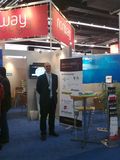 In what I personally see as a big step in the right direction, Intel and Nokia today announced that they have decided to combine their efforts in the mobile Linux landscape and merge Intel's Moblin and Nokia's Maemo platform. The new OS will be called MeeGo.
In what I personally see as a big step in the right direction, Intel and Nokia today announced that they have decided to combine their efforts in the mobile Linux landscape and merge Intel's Moblin and Nokia's Maemo platform. The new OS will be called MeeGo.
From a Nokia point of view I think it makes a lot of sense. While it was laudable to have a Linux based open source operating system running on their mobile devices starting with the N900, I guess I was not the only one wondering how they would manage to garner widespread developer support. With Intel and Nokia now walking the open source path together, MeeGo opens the door for other device manufacturers to come along. Who those will be was not announced today but the initiative will rise and fall with this support.
I hope the initiative will bear fruit because, as the Nokia spokesperson said, this is a "no walls no fences" thing. I expect that means, among other things, that developers and users will not be restricted to app stores for application downloads. Not that I don't like app stores in general.They are great to easily deliver applications to consumers but they also limit creativity as developers have to get the blessing of the app store owner. So with MeeGo hosted at the Linux Foundation I hope applications can be installed by any means as we go forward just like today.
Qt shall be the application development platform of choice and Nokia and Intel promise easy cross platform development across Symbian and MeeGo. As Nokia has so far preferred ARM processors I assume the partnership means MeeGo will also support the Intel platform. Unless, of course, if Nokia's first MeeGo device is Intel based. For native code that means that two different compiles of an application might be necessary to run on all MeeGo devices, plus an additional compile for Symbian.
The Ovi Store will be used as app store and the OS targets not only smartphones but also netbooks, tablets and other larger screen devices yet to be invented. It's a whole mouth full, let's see how they execute. The right stuff for me anyhow!





